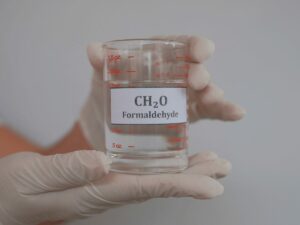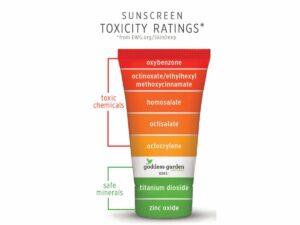Are you aware of the potential risks hiding in your makeup products? Identifying the ingredients to avoid in makeup is crucial for maintaining the integrity and health of the skin of your customers.
Our guidance is rooted in comprehensive research and industry expertise, offering a trusted resource for those seeking to navigate the complexities of cosmetic ingredients.
Here’s a sneak peek at 2 of the culprits, each with potential health risks:
In this guide, we will dive into the specifics of harmful ingredients, providing you with the knowledge to make safer choices in product development.
Read on for key insights toward healthier makeup solutions!
1. Parabens
Parabens, common preservatives in cosmetics, are forecasted to grow by 3.4% according to FMI, due to their role in extending product shelf life by preventing bacteria and mold growth. But, their safety has been called into question due to potential health impacts. Here are the reasons why it should be avoided:
- Hormonal Disruption: Parabens can mimic the body’s natural hormones, specifically estrogen, leading to imbalances. Such disruptions can have wide-ranging effects on both men and women, impacting health and well-being.
- Reproductive Problems: Studies have linked paraben exposure to fertility issues and potential reproductive system harm. These concerns highlight the importance of choosing paraben-free products, especially for individuals trying to become pregnant or maintain reproductive health.
- Skin Aging: Parabens may contribute to premature skin aging by weakening the skin’s collagen and elasticity. Avoiding these ingredients can help preserve skin health and vitality, reducing the appearance of fine lines and wrinkles.
- Increased Sensitivity: The use of paraben-containing products can lead to increased skin sensitivity and irritation, particularly for those with delicate or reactive skin. That is why, it is best to opt for paraben-free alternatives to mitigate these risks, promoting a healthier skin barrier.
- Cancer Risk: Preliminary research suggests a possible link between paraben exposure and an elevated risk of certain types of cancer. Although definitive proof is still needed, this potential link highlights the need to be cautious and stay away from these chemicals.

2. Phthalates
Phthalates, a group of chemicals commonly used in cosmetics to enhance flexibility and durability, have raised concerns among health and beauty professionals. Here are the crucial points to understand about phthalates and their impact:
- Endocrine Disruption: Phthalates are known to interfere with the body’s endocrine system, mimicking or blocking hormones. This disruption can lead to hormonal imbalances, affecting overall health and potentially leading to reproductive issues.
- Reproductive Health Concerns: Studies have linked phthalates to a decrease in fertility and reproductive health issues in both men and women. You see my point, right? Their ability to mimic hormones can have significant implications on reproductive functions.
- Developmental Effects: Exposure to phthalates during critical periods of development can have lasting effects. This includes potential impacts on the development of the reproductive system and other health issues in children.
- Respiratory Problems: In some individuals, phthalates may contribute to respiratory issues. While it may not bother everyone, individuals with existing health issues could experience worsened symptoms when exposed to it.
3. Formaldehyde
Formaldehyde, a volatile organic compound found in many cosmetic products, poses health concerns due to its use as a preservative and disinfectant which impacts product safety and skin health. Here are the key aspects to consider regarding formaldehyde in your cosmetic solutions:
- Carcinogenic Potential: Formaldehyde has been classified as a human carcinogen by international health organizations. Prolonged exposure may increase the risk of cancer, particularly nasal and throat cancers.
- Skin Irritation: This chemical can cause immediate skin irritation, showing up as redness, itching, and a burning feeling. Sensitive skin types are particularly vulnerable to these negative effects. Nako Cosmetic provides safe cosmetic solutions that ensure no skin irritation for users.
- Respiratory Issues: Inhalation of formaldehyde vapors can irritate the respiratory system, leading to coughing, wheezing, and in severe cases, asthma-like symptoms. Such reactions are concerning for both consumers and businesses.
- Eye Irritation: Formaldehyde exposure can irritate the eyes, causing redness, tearing, and discomfort. For example, this is particularly relevant for products applied near the eyes, such as makeup and eyelash glues.
- Immune System Sensitivity: Frequent exposure can make the immune system more sensitive, causing allergic reactions when encountering it again. As a matter of fact, this increased sensitivity can worsen over time, resulting in stronger reactions with ongoing exposure.

4. Synthetic Fragrances
Synthetic fragrances are widely used in makeup that offers a range of scents designed to make products more appealing. However, beneath their pleasant aromas lies a complex mix of chemicals that could be harmful to both skin health and overall wellbeing. Here are the key aspects to consider when evaluating synthetic fragrances in your cosmetic products:
- Allergic Reactions and Sensitivity: Synthetic fragrances are well-known for causing allergic reactions and sensitivities in many individuals. For example, these reactions can range from mild irritations to severe dermatitis, making them risky additives for those with sensitive skin.
- Hormonal Disruption: Compounds found in synthetic fragrances have been linked to hormonal imbalances. They can mimic hormones in the body, leading to potential disruptions in the endocrine system.
- Respiratory Concerns: Frequent exposure to synthetic fragrances can contribute to respiratory problems. Individuals with asthma or other respiratory conditions may find their symptoms worsened by these chemicals.
- Environmental Impact: The production and disposal of synthetic fragrances pose significant environmental concerns. These chemicals can pollute water and hurt animals, adding to the overall damage to the environment.
- Lack of Transparency: The term “fragrance” on ingredient lists can hide various synthetic chemicals. This lack of transparency makes it difficult for consumers to know what they’re applying to their skin, potentially exposing them to harmful substances.

5. Talc
Talc is commonly found in many cosmetic products like face powders and eyeshadows due to its ability to absorb moisture and provide a silky texture. However, it is currently being questioned due to the health risks associated with it. Here are the concerns associated with it:
- Respiratory Problems: Talc powder, when inhaled, can lead to respiratory problems. This is particularly concerning for products like loose powders, where particles can easily become airborne and inhaled during application.
- Contamination Concerns: Talc can be contaminated with asbestos, a known carcinogen. Asbestos-contaminated talc poses significant health risks, including cancer, when applied to the skin or inhaled.
- Skin Irritation: For individuals with sensitive skin, talc can cause dryness, itchiness, and irritation. It absorbs natural oils, which can leave the skin feeling uncomfortable and may even harm the skin barrier. So what’s my point? It’s crucial to prioritize talc-free alternatives for a gentler skincare experience.
- Ovarian Cancer Risk: There have been concerns about the use of talc powder in the genital area and an increased risk of ovarian cancer. Studies suggest that talc particles can travel through the reproductive system and become stuck in the ovarian tissue.
- Potential for Asbestosis: Exposure to asbestos-contaminated talc can lead to asbestosis, a chronic lung disease. Inhalation of asbestos fibers can cause damage on lung tissue, leading to long-term respiratory issues.

6. Toluene
Toluene, a volatile petrochemical solvent and paint thinner, is a common ingredient in nail polishes and hair coloring products. Its inclusion in cosmetics has raised concerns due to its potential health risks. Here are the key reasons to avoid this ingredient:
- Neurological Effects: Exposure to toluene can adversely affect the nervous system, leading to neurological symptoms such as headaches and dizziness. These symptoms indicate its potential to cause serious harm to brain function over time.
- Skin and Respiratory Irritation: This chemical is known to irritate the skin and respiratory system upon exposure. Individuals may experience dermatitis or respiratory discomfort, showcasing the chemical’s irritant properties.
- Reproductive Harm: Toluene poses significant risks to reproductive health, potentially leading to fertility issues and harm to fetal development. Its association with reproductive toxicity showcases the importance of avoiding exposure, especially in pregnant individuals.
- Immune System Impact: The immune system can be compromised by toluene exposure, weakening the body’s defense against infections and diseases. This highlights the broader health implications of toluene beyond its immediate toxic effects.
- Environmental Hazard: Toluene contributes to environmental pollution, posing risks not only to human health but also to wildlife and ecosystems. Its role as a pollutant highlights the need for responsible handling and usage to protect environmental health.

7. Polyethylene Glycols (PEGs)
Polyethylene Glycols (PEGs) are commonly utilized in cosmetics for their roles as thickeners, solvents, and moisture-carriers. However, their safety and impact on health have raised concerns. Here are the key areas of concern when it comes to PEGs:
- Irritation and Sensitivity: PEG compounds, particularly in damaged skin, can cause irritation and sensitivity. Their presence in skincare and makeup can worsen existing skin issues, so it’s wise to use them carefully.
- Contamination Concerns: PEGs may contain with harmful chemicals like ethylene oxide and 1,4-dioxane during manufacturing. These contaminants are linked to serious health risks, including cancer, which raises safety concerns for long-term use of products containing PEGs.
- Penetration Enhancement: PEGs serve as an entry point for the skin, allowing not only moisture but also potentially harmful ingredients from cosmetics to penetrate deeper. This could increase the likelihood of more serious health concerns.
- Environmental Impact: Besides health concerns, PEGs pose environmental issues. They are not easily degradable, contributing to pollution and building up pollutants in water, which harms aquatic creatures and the environment.
Here’s a table that outlines the environmental impact of PEGs (Polyethylene Glycols) in products:
| Aspect |
Description |
Impact |
| Non-degradability |
PEGs are not easily broken down in the environment. |
Pollution Contribution: Leads to accumulation in water bodies, contributing to long-term pollution. |
| Aquatic Toxicity |
The presence of PEGs in water can harm aquatic life due to their toxic effects. |
Harm to Aquatic Life: Affects the health and diversity of aquatic ecosystems. |
| Environmental Accumulation |
PEGs build up in the environment over time due to their stability. |
Ecosystem Impact: Contributes to the degradation of environmental quality and health. |
8. Oxybenzone and Octinoxate
Oxybenzone and Octinoxate are commonly found in a wide range of makeup and skincare products, particularly in sunscreens, due to their effectiveness in protecting the skin from UV radiation. However, emerging research suggests that their benefits may be outweighed by potential health and environmental risks. Here are the reasons why it’s crucial to reconsider their use in cosmetic products:
- Increased Skin Sensitivity and Allergic Reactions: These ingredients have been linked to increased skin sensitivity and allergic reactions that causes redness, itching, and discomfort upon exposure to the sun. It all boils down to prioritizing ingredient safety and efficacy for healthier skin outcomes.
- Hormonal Disruption: These chemicals are known to mimic hormones in the body, particularly estrogen, leading to potential hormonal imbalances. Such disruption can affect bodily functions and may contribute to long-term health issues.
- Coral Reef Damage: Oxybenzone and octinoxate are not just harmful to human health as they also pose a significant threat to marine life. When washed off in the ocean, they contribute to coral bleaching, harming marine ecosystems.
- Possible Developmental and Reproductive Toxicity: Research suggests that exposure to these substances can lead to developmental and reproductive toxicity. This concern is particularly relevant for pregnant women and young children, who may be more prone to their effects.
- Increased Risk of Skin Cancer: While used in products to protect against UV rays, they have been associated with an increased risk of skin cancer. Their potential to cause cellular damage and disrupt the natural repair processes of the skin raises concerns about their safety in sun protection products.

9. Siloxanes (Cyclomethicone, Cyclopentasiloxane)
Siloxanes, specifically Cyclomethicone and Cyclopentasiloxane, are commonly found in a wide range of cosmetic products due to their smoothing and lubricating properties. However, their safety and impact on both human health and the environment have raised concerns. Here are the key aspects to consider when evaluating the use of Siloxanes in cosmetics:
- Endocrine Disruption: Siloxanes are recognized for their endocrine-disrupting capabilities, mimicking natural hormones and possibly causing imbalances. This disruption can lead to significant health concerns, including hormonal imbalances.
- Reproductive Harm: Exposure to siloxanes has raised concerns regarding reproductive health. Research suggests they might interfere with the reproductive system, possibly leading to issues like reduced fertility or reproductive complications. So, it’s best to avoid using them in cosmetic solutions.
- Skin Irritation: Siloxanes, found in skincare and cosmetic products, may cause irritation for those with sensitive skin, possibly leading to conditions such as dermatitis. To avoid making skin problems worse, individuals with sensitive skin should opt for products that are free from siloxanes.
- Bioaccumulation Potential: The bioaccumulation potential of siloxanes is an environmental concern, as these chemicals can build up in the bodies of animals and humans over time. This accumulation poses long-term health risks, highlighting the importance of avoiding products with these substances.
10. Sodium Lauryl Sulfate (SLS) and Sodium Laureth Sulfate (SLES)
Sodium Lauryl Sulfate (SLS) and Sodium Laureth Sulfate (SLES) are widely used in cosmetics for their cleansing abilities and the foaming effect they produce. However, concerns about their impact on health and the environment have been raised due to their common presence in various personal care products. Here are the key reasons why the cosmetic industry is re-evaluating its use:
- Strips Natural Oils: SLS and SLES are known to remove the skin’s natural oils, leading to dryness and irritation. This effect can compromise the skin’s barrier function, making it vulnerable to external factors. Here’s what I think, opt for mild solutions to maintain skin health and hydration.
- Risk of Scalp Irritation and Hair Damage: These components might cause scalp irritation and harm hair roots, possibly resulting in dry, fragile hair and even hair loss. Their strong cleaning effect upsets the natural oil balance on both the scalp and hair.
- Can Exacerbate Acne: For those prone to acne, SLS and SLES may worsen the condition. They can increase irritation and clog pores, triggering breakouts or making existing acne more severe. Nako Cosmetic prioritizes safe and chemical-free beauty products.
- Potential Internal Health Risks: There are concerns about the potential internal health risks associated with long-term exposure to SLS and SLES, including their role in hormone disruption. These compounds can penetrate the skin and build up in the body over the years.

Conclusion
Navigating the complex landscape of cosmetic ingredients is essential for the development of safer and healthier skincare products. This guide serves as a foundation for understanding which ingredients to avoid, ultimately aiding in the formulation of products that cater to the well-being of your users.
For businesses in search of a makeup manufacturer that prioritizes safety and quality, Nako Cosmetic offers a trustworthy solution. To collaborate on reaching your product goals, please contact us today.






